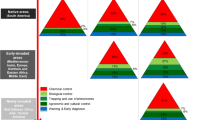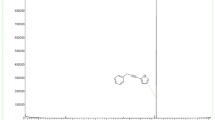Abstract
Host-plant resistance is one of the major components of integrated pest management programmes against the noctuid pod borer Helicoverpa armigera (Hübner) in chickpea. Survival and development of H. armigera on nine chickpea genotypes were compared using two food substrates, namely fresh leaves and pods, and artificial diets containing lyophilized leaf or pod powder of the same genotypes. Among the genotypes used, six showed different levels of resistance to H. armigera, while three were used as susceptible checks. Using leaves and pods, five of the resistant genotypes yielded lower larval weights compared to one of the susceptible checks used. Significant differences between four of the resistant and two of the susceptible genotypes were also observed when using artificial diets containing leaf or pod powder, but the rankings were different from that on the fresh leaves and pods. On both substrates, four resistant genotypes resulted in lower larval survival, pupation, adult emergence and fecundity when compared to one of the susceptible checks. A similar trend was also observed for larval survival and development when using F0i hybrids based on four of the resistant genotypes. Survival and development of H. armigera on the two food substrates, fresh leaves and pods and artificial diets with lyophilized leaf or pod powder, were highly correlated, suggesting that incorporation of lyophilized leaves or pods into the artificial diet can be used to assess antibiosis to H. armigera in chickpea.
Similar content being viewed by others
References
Armes N. J., Bond G. S. and Cooters R. J. (1992) The Laboratory Culture and Development of Helicoverpa armigera. Natural Resources Institute Bulletin No. 57. Natural Resources Institute, Chatham, Kent.
Chhabra K. S., Kooner B. S., Sharma A. K. and Saxena A. K. (1990) Sources of resistance in chickpea, role of biochemical components on the incidence of gram pod-borer Helicoverpa (Heliothis) armigera (Hubner). Indian Journal of Entomology 52, 423–430.
Cowgill S. E. and Lateef S. S. (1996) Identification of antibiotic and antixenotic resistance to Helicoverpa armigera (Lepidoptera: Noctuidae) in chickpea. Journal of Economic Entomology 89, 224–229.
Das S. B. and Kataria V. P. (1999) Relative susceptibility of chickpea genotypes against Helicoverpa armigera (Hubner). Insect Environment 5, 68–69.
Fitt G. P (1989) The ecology of Heliothis in relation to agro-ecosystems. Annual Review of Entomology 34, 17–52.
ICRISAT (1992) The Medium Term Plan. International Crops Research Institute for the Semi-Arid Tropics, Patancheru, Andhra Pradesh.
[IIE] International Institute of Entomology (1993) Distribution Maps of Plant Pests No. 15. Commonwealth Agricultural Bureaux International, Wallingford, Oxon.
Lateef S. S. (1985) Gram pod borer, Heliothis armigera (Hub.) resistance in chickpea. Agriculture, Ecosystems, and Environment 14, 95–102.
Lateef S. S. and Sachan J. C. (1990) Host-plant resistance to Helicoverpa armigera (Hub.) in different agroecological contexts in chickpea in the Nineties, pp. 181–190. In Proceedings of the Second International Workshop on Chickpea, 4–8 December 1989. International Crops Research Institute for the Semi-Arid Tropics (ICRI-SAT)/International Centre for Agricultural Research in the Dry Areas (ICARDA), Patancheru, Andhra Pradesh.
Schoonhoven L. M. (1990) Host selection by lepidopteran insects. The role of plant chemicals in oviposition and feeding behaviour in host selection behaviour of Helicoverpa armigera, pp. 9–11. In Summary Proceedings of the First Consultative Group Meeting, 5-7 March 1990. International Crops Research Institute for the Semi-Arid Tropics (ICRISAT), Patancheru, Andhra Pradesh.
Sharma H. C. (Ed.) (2005) Heliothis/Helicoverpa Management: Emerging Trends and Strategies for Future Research. Oxford and IBH Publishing Inc, New Delhi. 469 pp.
Sharma H. C, Gowda C. L. L., Sharma K. K., Gaur P. M., Mallikarjuna N., Buhariwalla H. K. and Crouch J. H. (2003) Host plant resistance to pod borer, Helicoverpa armigera in chickpea, pp. 118–137. In Chickpea Research for the Millennium. Proceedings of the International Chickpea Conference, 20–22 January 2003. Indira Gandhi Agricultural University, Raipur, Chattishgarh.
Sharma H. C, Ahmad R., Ujagir R., Yadav R. P., Singh R. and Ridsdill-Smith T. J. (2005a) Host plant resistance to cotton bollworm/legume pod borer, Heliothis/ Helicoverpa, pp. 167–208. In Heliothis/Helicoverpa Management: Emerging Trends and Strategies for Future Research (Edited by H. C. Sharma). Oxford and IBH Publishing Inc, New Delhi.
Sharma H. C, Pampapathy G. and Kumar R. (2005b) Standardization of cage techniques to screen chickpeas for resistance to Helicoverpa armigera (Lepidop-tera: Noctuidae) under greenhouse and field conditions. Journal of Economic Entomology 98, 210–216.
Sharma R. P. and Yadav R. P (2000) Construction of life tables to establish antibiosis resistance to the gram pod borer, Heliothis armigera (Hub) among chickpea genotypes. Journal of Entomological Research 24, 365–368.
Singh B. and Yadav R. P (1999a) Location of sources of resistance amongst chickpea (Cicer arietinum L.) genotypes against gram pod borer (Heliothis armigera Hub.) under normal sown conditions by using new parameters. Journal of Entomological Research 23, 19–26.
Singh B. and Yadav R. P (1999b) Field screening of chickpea (Cicer arietinum L.) genotypes against gram pod borer (Heliothis armigera Hub.) under late sown conditions. Journal of Entomological Research 23, 133–140.
Srivastava C. P. and Srivastava R. P (1990) Antibiosis in chickpea (Cicer arietinum) to gram pod borer, Heliothis armigera (Hubner) (Noctuidae: Lepidoptera) in India. Entomon 15, 89–94.
Yoshida M. and Shanower T. G. (2000) Helicoverpa armigera larval growth inhibition in artificial diet containing freeze-dried pigeonpea pod powder. Journal of Agriculture and Urban Entomology 17, 37–41.
Yoshida M., Cowgill S. E. and Wightman J. A. (1995) Mechanisms of resistance to Helicoverpa armigera (Lepidoptera: Noctuidae) in chickpea - role of oxalic acid in leaf exudates as an antibiotic factor. Journal of Economic Entomology 88, 1783–1786.
Author information
Authors and Affiliations
Corresponding author
Rights and permissions
About this article
Cite this article
Narayanamma, V.L., Sharma, H.C., Gowda, C.L.L. et al. Incorporation of lyophilized leaves and pods into artificial diets to assess the antibiosis component of resistance to pod borer Helicoverpa armigera (Lepidoptera: Noctuidae) in chickpea. Int J Trop Insect Sci 27, 191–198 (2008). https://doi.org/10.1017/S1742758407878374
Accepted:
Published:
Issue Date:
DOI: https://doi.org/10.1017/S1742758407878374




